How much do you really know about your body? After all, it's the one thing you carry with you your entire life, yet most people know more about computers and auto mechanics than they do their own bodily functions. While TV shows like House and Grey's Anatomy have most of us feeling like doctors, the truth is that we're much more similar to the clueless patients that we see being treated on these very shows.
Let's face it, simply looking at the picture below can be enough to give you feelings of hopelessness and anxiety...
 Credit: http://human-anatomy101.com/human-body-diagram-organs-female/
Credit: http://human-anatomy101.com/human-body-diagram-organs-female/
If you're anything like myself, you've spent most of your life wondering why you're in pain, why things aren't getting better, and just what the hell you can do about it. Doctors seem to have an entire language unto themselves, and as soon as you attempt to research just a tiny bit, you find yourself lost amongst a plethora of information that is orders of magnitude past your level of understanding.
What I'm here to tell you is, we can fix that. Understanding your body is extremely easy to do, as long as you know where to begin. It also happens to be endlessly fascinating to learn!
So where do we begin? How does someone start the journey of understanding their own body?
It's called the Anatomical Position.
Assume the Position!
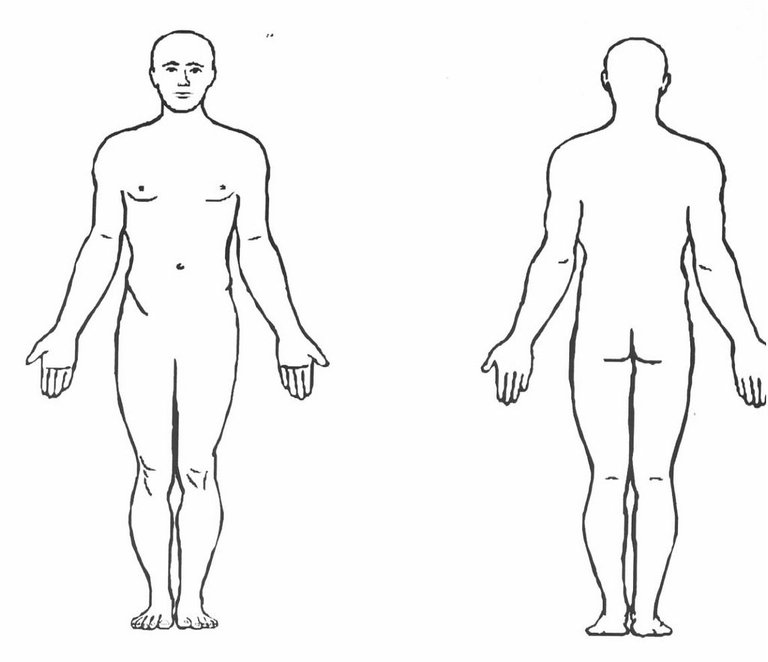 Credit: http://louisan.info/anatomical-position/
Credit: http://louisan.info/anatomical-position/
If we're going to have a useful conversation, we need to agree on the basics. It makes absolutely no sense for me to speak about where something in the body is located, if I don't take the time to specify which position the body is in to begin with. Anatomists realized this early on, and decided that a universal starting point would make it unnecessary to describe which position the body was in when mentioning the location of a particular structure.
The position they decided upon looks exactly like the picture above. When speaking about the location of a structure, it is assumed you are speaking about it from this perspective. If you're using a different position, that needs to be clearly stated from the beginning, otherwise you're sure to confuse people.
So how do we describe this position?
1. The body is standing upright. Not laying down on the belly, or side, but upright.
2. The arms are at rest by the sides of the torso. No hand waiving here!
3. The palms of the hand need to be facing in the forward direction. Another way of saying this would be that they're supinated, but we'll get to that a bit later.
4. The legs are close together. Standing with the legs spread apart can dramatically change the position of many structures in the leg.
5. The feet need to be flat on the ground. No standing on the tips of your toes here!
From this very simple position, we now have a way to communicate efficiently. For example, we can now say that your head is above your feet, or that your knees are below your belly. In fact, once we add in just a few more words, we can can get extremely specific.
Time to Learn Latin and Greek!
Medical terminology is a pain, let's be clear on that from the start. However, once you get the hang of it, it can be immensely beneficial. By simply knowing some basic etymology (the origin of a word, and it's historical meaning), you can begin to decipher even the most seemingly complex medical terminology.
There is enough terminology to create an entire course in and of itself. In fact, most Colleges, Universities, and even High Schools offer a class in Medical Terminology. For the sake of time, I will focus on the most used and necessary words for our current understanding.
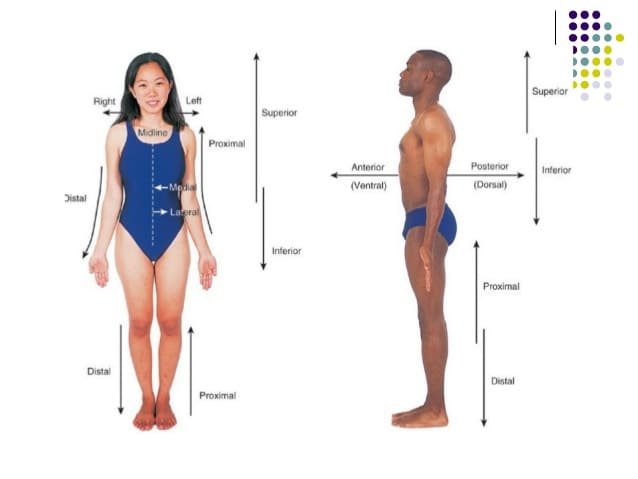 Credit: https://www.slideshare.net/abhachaorsiya/anatomical-positionppt-1
Credit: https://www.slideshare.net/abhachaorsiya/anatomical-positionppt-1
Anterior - Nearer to the front
-Ex. My sternum is anterior to my heart
Posterior - Further back in position
-Ex. My heart is posterior to my sternum
Dorsal - On the back
-Ex. My glutes are on the dorsal side of my body
Ventral - On the belly side
-Ex. My abs are on the ventral side of my body
Superior - Above
-Ex. My nose is superior to my mouth
Inferior - Below
-Ex. My mouth is inferior to my nose
Medial - Towards the mid-line
-Ex. My nose is medial to my eyes
Lateral - Away from the mid-line
-Ex. My eyes are lateral to my nose
Proximal - Closer to the point of origin
-Ex. My elbow is proximal to my wrist
Distal - Farther from the point of origin
-Ex. My wrist is distal to my elbow
These are the absolute "need to knows" when beginning our anatomy careers. Most of these are intuitive and easy to grasp, but a couple take a little time to fully understand. The most difficult terms for people to understand are usually Proximal and Distal. Lets take a moment to ensure these make sense.
Going the Distance
Proximal and Distal are only used when speaking about limb anatomy, or your arms and legs. They are used when you wish to discern distance from a specific point, or simply clarify which end of a structure you're speaking of. A good example would be with skeletal muscles.
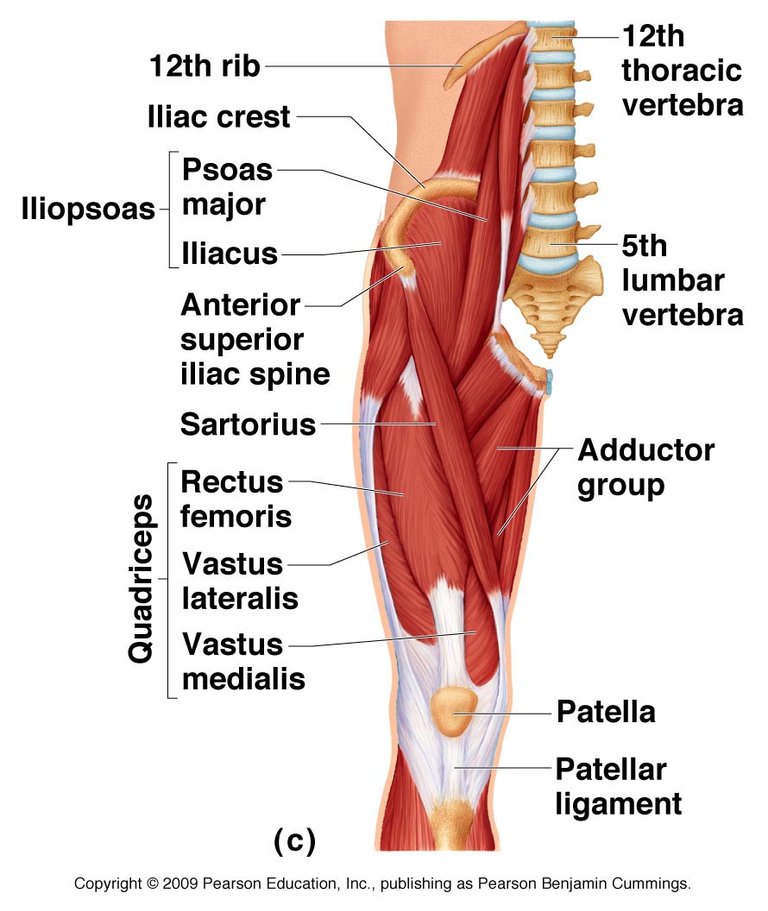
Skeletal muscles have multiple attachment sites on the skeleton, which is what allows for movement at the joints. While you could use the terminology Superior and Inferior when speaking about the ends of a particular muscle, it tends to much easier to use Proximal and Distal.
For example, looking at this picture of the muscles of the thigh, you can see that many of the muscles are traveling at angles, and not simply 'up and down'. In situations such as these, it's more common to say, the Proximal or Distal attachment, as opposed to the Superior or Inferior attachment. This is especially nifty when we start to learn about muscles and ligament injuries, such as 'sprains and strains'.
So when it comes to Proximal and Distal, it might be useful to think, "Closer to the torso, and farther from the torso".
Planes of Movement
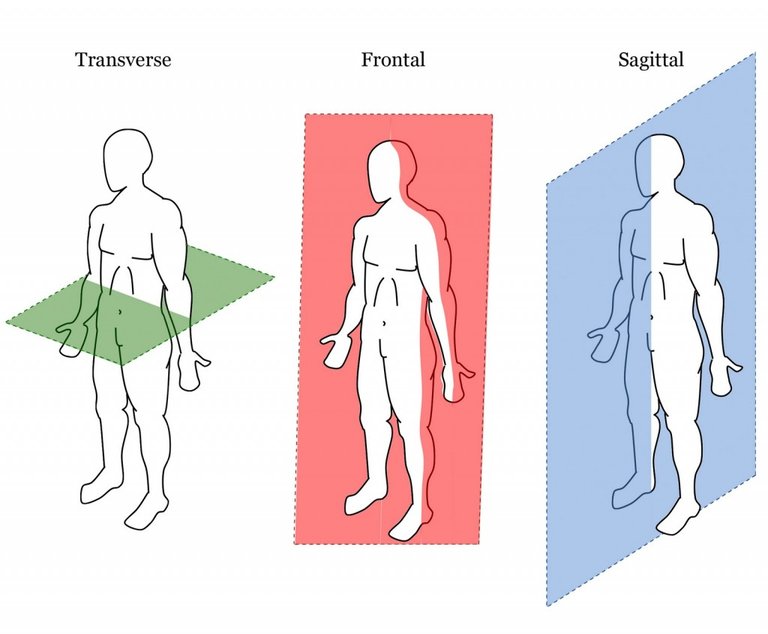 Credit: http://fullrangecrossfit.com/defending-the-deadlift/#.WWpRYumQzIU
Credit: http://fullrangecrossfit.com/defending-the-deadlift/#.WWpRYumQzIU
The last piece of this foundational puzzle are called Planes of Movement. These anatomical planes are simply another way to view the 3 Dimensions we live and operate within every day. They are useful in anatomy because the body can be literally cut into sections along these planes. From a Kinesiology standpoint, they are useful in determining the Range of Motion of muscles and joints.
The 3 Anatomical Planes are:
Transverse or Horizontal - Divides the body into superior and inferior portions
Frontal or Coronal - Divides the body into anterior and posterior portions
Sagittal - Divides the body into left and right portions
As these blogs progress, I will be using these planes more and more. I will begin to use real cadaver pictures that are cut into these planes. Here's an example of how useful these planes can be:
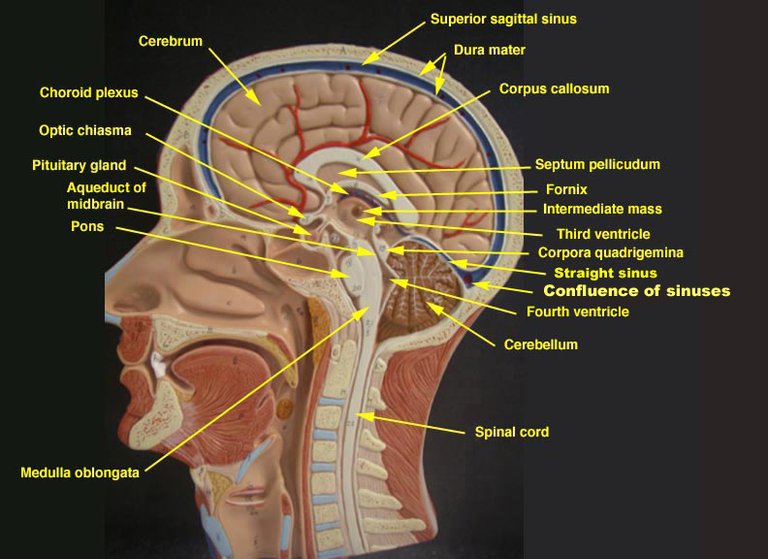 Credit: http://classroom.sdmesa.edu/anatomy/ModelPages/sagittal_head_model.htm
Credit: http://classroom.sdmesa.edu/anatomy/ModelPages/sagittal_head_model.htm
As you can see from this Sagittal section of a head, an immense amount of information can be gathered utilizing these viewpoints.
The Journey Has Begun
You now have the basic tools to begin your anatomy career. As with all sciences, anatomy builds on core concepts and ideas to create a coherent framework that will make anatomy not only easy to learn, but fun as well.
Stay tuned for more blog posts that will expand on these simple basic principles, and before you know it, your understanding of the human body will be at a whole new level!